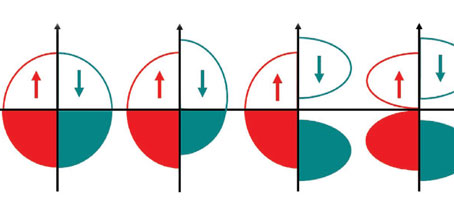- Quantum anomalous Hall effect (QAHE)-materials reviewed
- Magnetic topological insulators and spin-gapless semiconductors

Lead author PhD student, Muhammad Nadeem, University of Wollongong
A collaboration across three FLEET nodes has reviewed the fundamental theories underpinning the quantum anomalous Hall effect (QAHE).
QAHE is one of the most fascinating and important recent discoveries in condensed-matter physics.
It is key to the function of emerging ‘quantum’ materials, which offer potential for ultra-low energy electronics.
QAHE causes the flow of zero-resistance electrical current along the edges of a material.
QAHE in topological materials: key to low-energy electronics
Topological insulators, recognised by the Nobel Prize in Physics in 2016, are based on a quantum effect known as the quantum anomalous Hall effect (QAHE).
“Topological insulators conduct electricity only along their edges, where one-way ‘edge paths’ conducts electrons without the scattering that causes dissipation and heat in conventional materials,” explains lead author Muhammad Nadeem.
QAHE was first proposed by 2016 Nobel-recipient Prof Duncan Haldane (Manchester) in the 1980s, but it subsequently proved challenging to realize QAHE in real materials. Magnetic-doped topological insulators and spin-gapless semiconductors are the two best candidates for QAHE.
The quantum Hall effect (QHE) is a quantum-mechanical version of the Hall effect, in which a small voltage difference is created perpendicular to a current flow by an applied magnetic field.
The quantum Hall effect is observed in 2D systems at low temperatures within very strong magnetic fields, in which the Hall resistance undergoes quantum transitions — ie, it varies in discrete steps rather than smoothly.
QAHE describes an ‘unexpected’ (ie, ‘anomalous’) quantisation of the transverse ‘Hall’ resistance, accompanied by a considerable drop in longitudinal resistance.
QAHE is referred to as ‘anomalous’ because it occurs in the absence of any applied magnetic field, with the driving force instead provided by either a) spin-orbit coupling or b) intrinsic magnetization.
Researchers seek to enhance these two driving factors in order to strengthen QAHE, allowing for topological electronics that would be viable for room-temperature operation.
It’s an area of great interest for technologists,” explains Xiaolin Wang. “They are interested in using this significant reduction in resistance to significantly reduce the power consumption in electronic devices.”
“We hope this study will shed light on the fundamental theoretical perspectives of quantum anomalous Hall materials,” says co-author Prof Michael Fuhrer (Monash University), who is Director of FLEET.
The study
The collaborative, theoretical study concentrates on these two mechanisms:
- large spin-orbit coupling (interaction between electrons’ movement and their spin)
- strong intrinsic magnetization (ferromagnetism)
Four models were reviewed that could enhance these two effects, and thus enhance QAHE, allowing topological insulators and spin fully-polarized zero-gap materials (spin gapless semiconductors) to function at higher temperatures.
“Among the various candidate materials for QAHE, spin-gapless semiconductors could be of potential interest for future topological electronics/spintronics applications”, explains Muhammad Nadeem.
Quantum Anomalous Hall Effect in Magnetic Doped Topological Insulators and Ferromagnetic Spin-Gapless Semiconductors – A Perspective Review was published in the journal Small in September 2020 (DOI 10.1002/smll.201904322).
The study was supported by the Australian Research Council (Centres of Excellence and Future Fellowship projects).
Topological materials at FLEET
 Topological materials and other novel quantum states are studied at FLEET, an Australian Research Council Centre of Excellence, within the Centre’s Research theme 1 and Enabling technology A.
Topological materials and other novel quantum states are studied at FLEET, an Australian Research Council Centre of Excellence, within the Centre’s Research theme 1 and Enabling technology A.
The Centre for Future Low-Energy Electronics Technologies (FLEET) is a collaboration of over a hundred researchers, seeking to develop ultra-low energy electronics to face the challenge of energy use in computation, which already consumes 8% of global electricity, and is doubling each decade.

FLEET will develop 2D topological insulators with large bandgaps in their interior, sufficient for conduction of edge modes at room temperature without dissipation. Ultra-low power topological transistors will be developed, in which the dissipationless channel along the boundary between a topological and conventional insulator is switched on and off by the application of a gate voltage.
The review’s leading author Muhammad Nadeem is a FLEET PhD student under Prof Xiaolin Wang’s supervision at UOW node of FLEET.
Prof Xiaolin Wang leads FLEET’s University of Wollongong node, as well as leading the Enabling Technology team developing the novel and atomically thin materials underpinning FLEET’s search for ultra-low energy electronics, managing synthesis and characterisation of novel 2D materials at the University of Wollongong. Prof Wang is also the Director of Institute of Superconducting and Electronic Materials, UOW.
Prof Alex Hamilton leads FLEET’s UNSW node, is the Centre’s Deputy Director, and leads research theme 1, which studies the use of topological materials.
Prof Michael Fuhrer (Monash University) is Director of FLEET and has pioneered studies of electronic properties of 2D materials, including synthesising and studying 2D topological insulators with large bandgaps in FLEET’s Research theme 1.
More information
- Contact Muhammad Nadeem (University of Wollongong), mn308@uowmail.edu.au
- Contact Prof Xiaolin Wang (University of Wollongong) xiaolin@uow.edu.au
- Read Spin-gapless semiconductors


